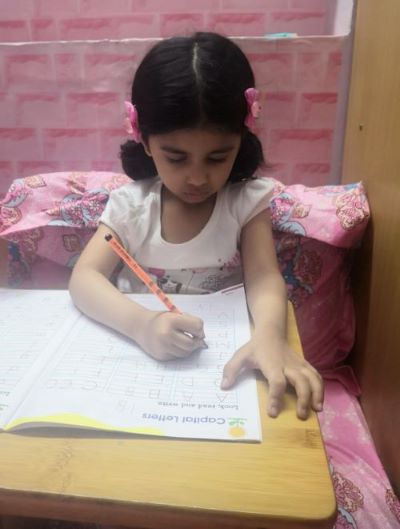Homeschooling had never been a concept in India before this pandemic hit the world. Afterwards, either no schooling or home schooling were only two options for very young kids (because online classes are not effective for that age). Those who did not want to compromise on their child’s learning chose home schooling.
But home schooling again is a challenge with young kids. It is really difficult to make the child sit, get him in routine and make him learn.
I am home schooling my daughter since April 2020 (when she technically entered Nursery class) and it is going great.
So, here are the points that I have learnt from my experience.
1. Prepare your child mentally
First of all, start telling your child that now his school is going to be started again. But since there is a virus outside, school will be at home itself. This will help him in accepting the concept of homeschooling. Give him at least 3-4 days for this. During this time, prepare with him. That means, apart from telling him, do other preparations too in his presence, like collecting his book, setting up the space etc. Involve the child in preparations as much as possible.
2. Fixed Time
Then choose a fixed time when you’ll be teaching him daily. Fixed time will help him in accepting the routine, and his tendency to avoid studying and negotiating will be less.
3. Fixed Place
Just like time, fix a place too . Make that place appropriate for studying. It can be a small corner with just a table chair. Put the charts there. Stack up the books nearby. It can be very simple, but the child should be getting a feel that this is the space for studying.
4. Shorter Sessions
From a 3-5 years old child, do not expect long study sessions. 30 minutes (or even less) is enough at this age. The best you can do is to have 2 sessions 20-30 minutes each. For example, first from 11 am to 11:30, and then 4 pm to 4:30, or whatever time is suitable for you.
In the starting, it is possible that the child may get distracted just after 10 minutes. It’s fine. 10 minutes is okay in the starting. Gradually increase the time.
Remember, these 30-60 minutes are only for structured learning, and to put the child into the habit of sitting and concentrating. Otherwise, at this age, learning takes place all through the day, with everything you do with your child, with everything you say to your child.
5. Use Books
Use colorful and attractive books. For example, for writing practice, use writing books instead of plain notebooks. That will attract the child’s interest.
6. Activity Books
Buy a lot of activity books (easily available on stationery shops and amazon). My daughter hates writing, but is very much interested in activity books.
I am soon going to share on my page few links of activity books.
7. Get Syllabus and Ideas on What to teach
Get the syllabus of Nursery/LKG/UKG class. You can ask from child’s previous school, or is available on Google and Facebook also. I have also uploaded the syllabus of Nursery/LKG class on my page. Go to the FB page of HappyWomanhood (link at the end) and search in the search bar using keyword #nurseryclasssyllabus
8. Be easy, but consistent with Writing practice
It is very common that kids don’t like writing. So be a little easy, but consistent with writing. For example, don’t ask the child to write one full page in one go. Instead ask him to write a number/alphabet 5-8 times a day. This way, the child won’t feel pressurized and won’t lose interest in writing.
9. Use Flash cards and Charts
In case you are not using flash cards and big charts, do buy them. I have posted on my FB page a sample video and links of flash cards and charts. Search in the search bar using keyword #teachingaids
10. Schooling is not just alphabets and numbers
Apart from syllabus and academic things, there are several concepts that you can teach.
Please go through my page. You will find several such ideas and videos.
Remember that schooling and those 30 minutes is not only about writing and learning numbers and alphabets. Other concepts too are to be included in schooling. If we keep teaching only numbers and alphabets, the child will get bored of studying.
11. Make and Follow Timetable
Make a schedule. Make a timetable every week of what will you teach each day.
Sample Time Table:
Monday: Writing Practice, Activity involving Alphabets
Tuesday: Writing Practice, Count and Match/Write/ Tell (using books or real objects), Coloring
Wednesday: Writing Practice, Learning and Practicing New words
Thursday: Writing Practice, Learning Rhymes (with meaning)
Friday: Writing Practice, Activity Book
Saturday: Writing Practice, One New Concept, example Seasons, Types of Transport etc.
This is just a sample. Topics you choose obviously depends on the age of your child, how much your child already knows, and for how long your child is able to sit and study. For example, if you are teaching 2 years old kid, you will be teaching him recognition of alphabets instead of writing, while if you are teaching 4 years old, you will be making him write small alphabets.
On my FB page, I regularly share ideas on what and how you can teach. In coming days, I am going to share about books etc. too.
So do scroll through the page. And follow/like the page if you haven’t already, so that you don’t miss the coming videos.
Please feel free to ask anything else you want to ask, (through messenger). I am no expert, but will try to help you with the best of my knowledge and experience.
.
If you found this article useful, please follow the Facebook Page to stay connected and be notified of more such useful articles in future, on parenting, health, nutrition, education, values, and much more.
Please connect on Instagram for daily updates and quick tips.
.
Also Read:
Teaching Toddlers at Home: Right or Wrong?
How To Teach Toddlers/ Young Kids. Part 1 (Alphabets and Numbers)
How to Teach Toddlers: Part II (Colors, Shapes and more)
Home Made Flavorsome Giloy Syrup for Immunity





